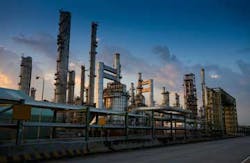The market for refinery catalysts in the oil refining sector is expected to be worth $6,707.92 million in five years' time, after expanding at a compound annual growth rate (CAGR) of 4.24% between 2014 and 2019.
Refining catalysts are used in petroleum refineries to enhance throughput. They help refiners meet fuel standards, manage operational efficiency, enhance conversion and selectivity and keep pace with environmental trends.
A new report from Markets and Markets examines the global market for refinery catalysts, looking in detail at fluid catalytic cracking, hydro treating, hydrocracking and alkylation, all of which are used in refineries to increase the efficiency of refining operations.
Hydro treating catalysts dominate the refinery catalysts market, with a projected market value of $2,213.05 million by 2019.
According to Markets and Markets, the refinery catalysts market is witnessing high growth because of rising demand for transportation fuels and increased consumption of petroleum-based derivatives.
Stringent environmental regulations and demand for high octane number are further driving the refinery catalysts market, the research firm said.
As a result of the boom in development of unconventional oil and gas deposits, shale oil is becoming a major feed source for many refineries. While these feedstocks are generally sweet and light, refiners face a number of issues when processing tight oil, including contaminant metals and heat balance effects in the refinery.
Refinery catalysts provide solutions for metals tolerance, while achieving maximum conversion and selectivity on light feeds and optimum butylene selectivity. Refiners can now apply new catalyst technologies to maximize the value present in tight oil feedstocks, Markets and Markets explained.
In the future, refinery processes will need to have more flexibility in order to respond to changes in product demand and the availability of specific crudes. This means that continuous innovations in the field of petroleum refining are needed. With petroleum predicted to remain the most important single resource for transportation through 2050, the development of new refinery technologies and catalysts will continue to be very important in the coming years.
